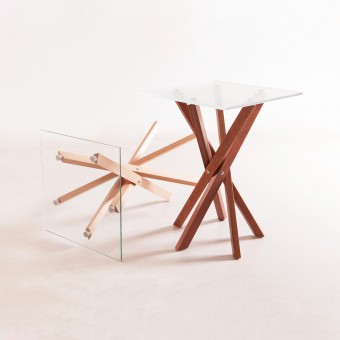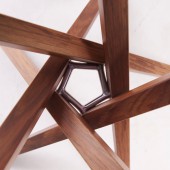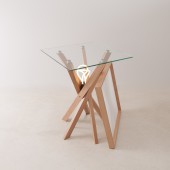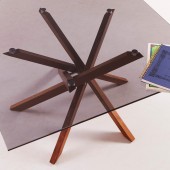
| THE AWARD |
| CATEGORIES |
| REGISTRATION |
| SUBMIT YOUR WORK |
| ENTRY INSTRUCTIONS |
| TERMS & CONDITIONS |
| PUBLICATIONS |
| DATES & FEES |
| METHODOLOGY |
| CONTACT |
| WINNERS |
| PRESS ROOM |
| GET INVOLVED |
| DESIGN PRIZE |
| DESIGN STORE |
| THE AWARD | JURY | CATEGORIES | REGISTRATION | PRESS | WINNERS | PUBLICATIONS | ENTRY INSTRUCTIONS |
Pende Multifunctional Table by Harry Strouzas |
Home > Winners > Design #65851 >Interview |
 |
|
FS: What is the main principle, idea and inspiration behind your design?
HS: I have always really liked the criss-cross, angled, spiralling form. But I have never seen it done in a manner which achieves ALL of the following points simultaneously. (a) Utilises straight legs of minimal proportions; (b) Has no complicated joinery techniques which removes material and decreases strength; (c) Can be flat packed; (d) Is very easy to assemble/disassemble; (e) Is strong enough to accept a heavy load and be used as a large dining table; (f) Is versatile enough to be used in different types of products, such as stools, lights, coat racks, chairs etc; (f) Can be scaled up or down to cater for different designs; and (g) uses the applicable principles of geometry and physics and thus can therefore be adapted to varying leg numbers as desired or required.
FS: What has been your main focus in designing this work? Especially what did you want to achieve?
HS: In essence, I wanted to find a better way to create the visually appealing criss-crossing, under-frame form. By better I refer to achieving ALL of the above points mentioned above. I really wanted to override the numerous limitations that this form has experienced in the past. Limitations such as having to utilise large section material which then has to undergo complicated, compound angle joinery, which consequently removes much of the material anyway at the predominant point of stress. I also never liked it when small section members where used in this criss-cross form, as they either needed a massive number of legs (think bamboo stick spirals) or they were never able to accept decent loads. Hence such thinner legs versions could only ever become tall and skinny lamps for example. Their functionality would always become compromised due to the inefficient design, and they could never spread far enough to become really useful as a structural form.
FS: What are your future plans for this award winning design?
HS: I would love to utilise the overall premise with a view to designing a range of different products and also explore utilising varying numbers of legs to achieve different forms and types of furniture. I would love a manufacturer with similar design sensitivities to PodMarket™ to handle the production side of things on a larger scale as I further develop and expand the range.
FS: How long did it take you to design this particular concept?
HS: Not completely sure to be totally honest. From my initial thought process to the existence of the fully resolved piece, my best guess would be approximately 2 years (on and off). The prototyping process and engineering resolution took the best part of six months.
FS: Why did you design this particular concept? Was this design commissioned or did you decide to pursuit an inspiration?
HS: This was a self driven project. I had no idea that it would actually work and meet all the criteria that I had set out to achieve. The idea and thinking that it should be possible had entered my head a long time ago, but I never had the time to sit down and really thrash out the design. When I began my own business however, things changed pretty quickly and I decided to pursue this concept properly. I'm so glad that I did.
FS: Is your design being produced or used by another company, or do you plan to sell or lease the production rights or do you intent to produce your work yourself?
HS: We are currently co-ordinating production of the pieces ourselves in Melbourne, Australia. Ideally we would like to licence the production to like minded, high quality, ecologically minded manufacturers, whilst we focus on expanding the range and working on our next designs. I think there is a lot of potential for this design here in Europe and in North America and Asia due to it's ability to be mass produced and offered in different sizes and at different price points.
FS: What made you design this particular type of work?
HS: Nothing made me do it. But rather I actually wanted to pursue the concept and develop it fully as it had been floating around in my head for a long time beforehand.
FS: Where there any other designs and/or designers that helped the influence the design of your work?
HS: No, except for my co-designer Fiona McKenzie of course. I was convinced that the traditional ways of achieving the criss-cross under-frame form were simply too wasteful, too thick and clumsy and that it could be achieved much more simply and elegantly.
FS: Who is the target customer for his design?
HS: People who really appreciate minimalism and versatility in their products. People who don’t gravitate to unnecessary components or superfluous decoration that serve no purpose. People who dislike waste and inefficient designs. People who like clever and resolved solutions.
FS: What sets this design apart from other similar or resembling concepts?
HS: I have never seen criss-cross, spiralling under-frame meet ALL of the following points simultaneously. (a) Utilises straight legs of minimal proportions; (b) Has no complicated joinery techniques which removes material and decreases strength; (c) Can be flat packed; (d) Is very easy to assemble/disassemble; (e) Is strong enough to accept a heavy load and be used as a large dining table; (f) Is versatile enough to be used in different types of products, such as stools, lights, coat racks, chairs etc; (f) Can be scaled up or down to cater for different designs; and (g) uses the applicable principles of geometry and physics and thus can therefore be adapted to varying leg numbers as desired or required. The design's versatility and scaleability is leaps and bounds ahead of any overly chunky table frame or flimsy, lightweight lamp that could never sustain a significant load. It is a truly resolved and elegant solution.
FS: How did you come up with the name for this design? What does it mean?
HS: I have a Greek background. Both my parents were born in the Peloponnese, before moving to Melbourne, Australia. I was born in Melbourne. In the first evolution of this concept, Fiona and I decided to utilise 5 legs with a central pentagon bracket. Pende is the Greek work for the number five. It seemed right to use this clean, uncluttered name for this clean, uncluttered design.
FS: Which design tools did you use when you were working on this project?
HS: Hand sketches, 3-D CAD, prototyping, research into forces and physics via reading and discussions with structural and mechanical engineers, more drawings, more prototyping and use of full scale mock ups with furniture makers and steel fabricators.
FS: What is the most unique aspect of your design?
HS: That it can handle any type of central polygon shape and that there is a direct relationship between the number of edges of that polygon shape to the number of supporting legs that it can sustain.
FS: Who did you collaborate with for this design? Did you work with people with technical / specialized skills?
HS: Fiona McKenzie and I always work closely together on every design that PodMarket™ develops. I also worked closely with our head furniture craftsman and two highly skilled engineers (one structural, one mechanical). Both had exceptional knowledge about the utilisation of steel and combining it with timber, as well as geometry and the physical effects of loads and gravitational forces on structural forms.
FS: What is the role of technology in this particular design?
HS: Everything was finalised and confirmed utilising CAD. The precise nature of the compound angles relating to the positioning of each leg demanded pin point accuracy. We’re now exploring the use of casting technology to further mechanise and accurately replicate the production of the steel polygon brackets. In the initial versions these brackets have been welded together.
FS: Is your design influenced by data or analytical research in any way? What kind of research did you conduct for making this design?
HS: Whilst developing the concept, I worked closely with our head furniture craftsman and two highly skilled engineers (one structural, one mechanical). Both had exceptional knowledge about the utilisation of steel and combining it with timber. They also both excelled at mathematics (generally) and geometry (specifically), as well as knowing the physical effects of loads and gravitational forces on various types of structural forms. This analysis and research into the effects of forces proved essential in resolving the issues faced and finalising the central junctions.
FS: What are some of the challenges you faced during the design/realization of your concept?
HS: Initially, I couldn't stop the legs from continuing to spread apart when subjected to gravitational force. The legs kept "slipping" and I couldn't understand why the initial brackets weren't doing a better job of holding them tight and in their required formation. I trialed a few different bracket configurations and discussed this issue with my engineering contacts, before finding the reason. At that stage it was easy to design a better bracket which did the job as required. Hence, sometimes you can draw all you like and still not get the final result you desire. Nothing beats full sized mock-ups and test rigs when you're trying to resolve the finer details.
FS: How did you decide to submit your design to an international design competition?
HS: Same reason as to why we've registered the design and have a patent pending. When it comes right down to it, Fiona and I have in fact come up with a new invention. It's a totally novel way of creating this criss-cross, spiralling under-frame form which simply has never been done before. So why not see how it performed on the world stage?
FS: What did you learn or how did you improve yourself during the designing of this work?
HS: I learned a lot about geometry, physics and structural forces. I needed to get answers to a few questions that I had, which required specialist knowledge from different sources. I learned that you really do need to stay true to your vision and belief that something can work, even when some people around you say that it's not possible. I learned (again) that you can't solve every problem entirely on your own. And I learned that there are certain types of people out there who really do want to help out and volunteer their knowledge and learnings, when they are posed with an intriguing issue in their field of interest.
FS: Thank you for providing us with this opportunity to interview you.
A' Design Award and Competitions grants rights to press members and bloggers to use parts of this interview. This interview is provided as it is; DesignPRWire and A' Design Award and Competitions cannot be held responsible for the answers given by participating designers.
| SOCIAL |
| + Add to Likes / Favorites | Send to My Email | Comment | View Press-Release |





